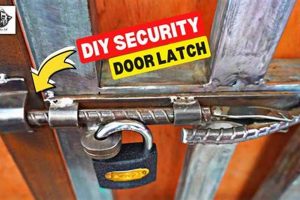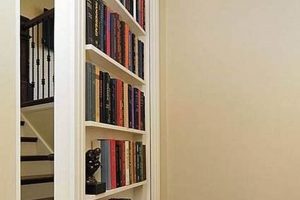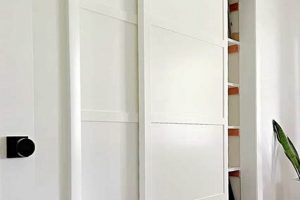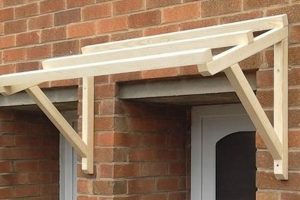A self-executed pet passage construction allows canine companions independent access to the outdoors. This typically involves modifying an existing door or wall to accommodate a hinged or sliding opening designed specifically for animal entry and exit. For instance, a homeowner might install a flap within a back door frame, enabling a dog to move freely between the interior and exterior of the residence without human assistance.
The creation of such a feature offers advantages in terms of pet autonomy, reducing reliance on human intervention for bathroom breaks and outdoor recreation. Historically, variations of this concept have existed for centuries, evolving from simple holes in walls to more sophisticated manufactured solutions. The recent surge in do-it-yourself approaches provides a cost-effective and customizable alternative to professionally installed options, empowering individuals to tailor the passage to their specific pet’s size and household aesthetics.
The subsequent discussion will delve into the various design considerations, material selections, and installation techniques associated with this construction. It will address crucial factors such as ensuring weather resistance, maintaining home security, and acclimating the animal to the newly installed portal.
Construction Guidance
The following guidelines aim to assist individuals in the creation of a functional and secure pet access point.
Tip 1: Accurate Measurement is Paramount: Before initiating any cuts, meticulously measure the animal’s height and width at the shoulders. Add a minimum of two inches to both dimensions to ensure comfortable passage. This will prevent the animal from having to crouch or squeeze through the opening, reducing hesitation and promoting ease of use.
Tip 2: Material Selection Affects Longevity: Opt for weather-resistant materials like treated lumber, durable plastics, or metal sheeting for the frame and door. This will prevent premature degradation due to exposure to the elements, ensuring the passage’s structural integrity over time. Avoid porous materials that can absorb moisture and promote mold growth.
Tip 3: Weatherproofing Minimizes Energy Loss: Implement weather stripping around the perimeter of the door flap and frame to minimize drafts and heat loss. Magnetic closures can further enhance the seal, preventing unwanted airflow and contributing to energy efficiency. Consider using insulated flaps for climates with extreme temperatures.
Tip 4: Security Reinforcements Deter Intruders: Reinforce the door frame with metal brackets or additional screws to prevent forced entry. Consider installing a locking mechanism, such as a slide bolt or deadbolt, that can be engaged when the passage is not in use, particularly during extended absences from the residence.
Tip 5: Gradual Acclimation Encourages Use: Introduce the animal to the new passage in a positive and encouraging manner. Initially, prop the flap open and coax the animal through with treats or toys. Gradually reduce the opening until the animal confidently pushes through the flap on its own. Avoid forcing the animal through, as this can create a negative association.
Tip 6: Placement Considerations Improve Safety: Locate the passage in an area with good visibility on both sides. This will allow the animal to assess its surroundings before entering or exiting, reducing the risk of collisions or encounters with other animals. Avoid placing the passage near hazardous areas, such as swimming pools or busy roads.
These guidelines provide a starting point for a successful project. Careful planning and execution are key to creating a safe and functional addition to the home.
The subsequent sections will explore specific design options and detailed installation procedures.
1. Sizing specifications
Dimensional accuracy constitutes a fundamental prerequisite for a functional self-installed pet passage. Inadequate sizing specifications directly impact the usability of the structure, potentially causing discomfort, hesitation, or even physical injury to the animal. For instance, a passage with insufficient height may force the pet to crouch excessively, leading to spinal strain over time. Conversely, an excessively large opening compromises energy efficiency and poses potential security risks.
The cause-and-effect relationship between accurate measurement and successful implementation is readily demonstrable. Consider a situation where a homeowner, lacking precise measurements, constructs an opening based on an estimated size. The resulting passage might prove too narrow for the pet’s shoulders, hindering passage and ultimately rendering the modification useless. Conversely, a passage precisely tailored to the animal’s dimensions promotes seamless and comfortable movement, thereby maximizing the utility of the self-installed feature. Proper size is also a key factor to keep other animal outside.
Therefore, meticulous attention to sizing specifications is not merely a detail but a critical element determining the overall success of a constructed pet passage. The challenges associated with inaccurate measurements necessitate a proactive approach, emphasizing thorough assessment and precise execution. Accurate sizing specifications ensures the pet’s comfort and willingness to use the passage, but also contributes to the thermal efficiency and security of the residence.
2. Material durability
Material durability constitutes a critical determinant of the long-term viability and functionality of any self-installed pet passage. The selected materials must withstand constant usage, exposure to environmental elements, and potential physical stress exerted by the animal, if not consider the challenge from other animals.
- Weather Resistance
External-facing components of a pet passage are continually subjected to varying weather conditions, including rain, snow, and direct sunlight. Materials lacking inherent weather resistance, such as untreated wood, degrade rapidly, leading to structural weakening, warping, and eventual failure. Durable materials, like treated lumber or marine-grade polymer, resist moisture absorption and UV damage, extending the lifespan of the installation. The selection of appropriately weather-resistant materials directly mitigates the need for frequent repairs or replacements.
- Impact Resistance
The door flap or sliding panel experiences repeated impact from the animal’s entry and exit. Brittle materials, such as thin acrylic sheets, are prone to cracking or shattering under stress. Durable materials, such as high-density polyethylene or reinforced polycarbonate, exhibit greater impact resistance, withstanding repeated contact without compromising structural integrity. Consider the size and breed of the dog, some dogs can be very destructive.
- Pest Resistance
Wooden components of a pet passage are susceptible to infestation by insects, such as termites or carpenter ants, leading to structural damage and eventual collapse. Materials treated with insect repellents or naturally resistant woods, such as cedar or redwood, deter pest activity, preserving the integrity of the installation. In regions with high pest populations, the utilization of pest-resistant materials is essential for long-term performance.
- Scratch Resistance
The surface of the pet passage, particularly the frame and flap, may experience scratching from the animal’s claws or teeth. Materials with low scratch resistance, such as soft plastics, exhibit unsightly marks and diminished aesthetic appeal over time. Durable materials, such as powder-coated metal or textured composites, resist scratching, maintaining their original appearance and prolonging the lifespan of the installation. Materials like this can increase the value.
In conclusion, the selection of durable materials significantly impacts the long-term functionality, aesthetic appeal, and overall value of a self-installed pet passage. The initial investment in high-quality, durable materials translates to reduced maintenance costs, enhanced security, and extended service life, ultimately providing superior value over time.
3. Weather resistance
The incorporation of weather resistance in a self-installed pet passage is a critical factor affecting the structure’s longevity and the overall energy efficiency of the residence. Lack of adequate weatherproofing measures initiates a cascade of detrimental effects. For instance, moisture penetration can lead to wood rot, corrosion of metallic components, and the growth of mold or mildew, compromising the structural integrity of the pet passage and potentially impacting indoor air quality. This, in turn, necessitates costly repairs or premature replacement, negating the initial cost savings associated with a do-it-yourself approach.
Effective weather resistance is achieved through several key strategies. The implementation of tight seals around the perimeter of the pet door flap or sliding panel prevents drafts and water intrusion. The selection of water-resistant or waterproof materials, such as treated lumber or closed-cell foam insulation, further mitigates the risk of moisture damage. Additionally, the strategic placement of the pet passage, avoiding direct exposure to prevailing winds and precipitation, can significantly reduce the burden on weatherproofing measures. For example, a pet door installed on a sheltered porch experiences considerably less weather exposure than one directly facing the elements.
Ultimately, the integration of robust weather resistance measures into a self-installed pet passage represents a fundamental investment in the structure’s durability and the overall comfort of the home. The challenges associated with inadequate weatherproofing underscore the importance of meticulous planning, careful material selection, and precise installation techniques. Prioritizing weather resistance not only extends the lifespan of the pet passage but also contributes to reduced energy consumption and improved indoor environmental quality, thereby maximizing the long-term value of the do-it-yourself project.
4. Security measures
The integration of robust security measures constitutes a paramount concern when undertaking the self-installation of a pet passage. A compromised pet access point can serve as a potential entry point for intruders, thereby negating the security benefits of conventional doors and windows. Therefore, a comprehensive understanding of security vulnerabilities and the implementation of appropriate countermeasures are essential to mitigate risks and safeguard the residence.
- Reinforced Frame Construction
The structural integrity of the pet passage frame directly impacts its resistance to forced entry. A weakly constructed frame can be easily breached with minimal effort. Employing reinforced materials, such as metal bracing or solid hardwood, and utilizing secure fastening methods, such as long screws anchored into the door frame studs, significantly enhances the frame’s ability to withstand physical attacks. Real-world examples demonstrate that frames constructed from flimsy materials are often the first point of failure during attempted burglaries. The implications of a poorly reinforced frame extend beyond property loss, potentially compromising the safety of occupants.
- Secure Locking Mechanisms
Many commercially available pet doors incorporate basic locking mechanisms, such as slide bolts or snap-fit closures. However, these mechanisms often prove inadequate against determined intruders. Implementing robust locking systems, such as deadbolts or keyed locks, significantly elevates the security level of the pet passage. These mechanisms should be constructed from hardened steel and designed to resist tampering. For example, a deadbolt lock that extends deep into the door frame provides a substantially higher level of security than a simple slide bolt. The installation of secure locking mechanisms serves as a primary deterrent against unauthorized entry.
- Tamper-Resistant Flap Design
The pet door flap itself can be a vulnerable point if not properly designed and secured. A flimsy or easily removable flap allows intruders to gain access by simply removing or manipulating the flap mechanism. Incorporating tamper-resistant features, such as a multi-point locking system or a recessed flap design that is difficult to pry open, significantly enhances security. Some designs incorporate magnets that hold the flap securely in place, making it more difficult to force open from the outside. A robust flap design serves as a critical barrier against unauthorized entry and manipulation.
- Alarm System Integration
Integrating the pet passage into the home’s existing alarm system provides an additional layer of security. Sensors can be installed on the pet door flap to detect unauthorized openings. When the alarm system is armed, any breach of the pet passage triggers an immediate alarm response. For example, a magnetic contact switch can be installed on the door frame and flap, triggering an alarm if the magnetic connection is broken. Alarm system integration provides real-time monitoring and immediate notification of potential security breaches, allowing for a prompt response to mitigate risks.
The aforementioned security measures are not mutually exclusive and should be implemented in combination to provide a comprehensive security solution. While no security system can guarantee absolute protection, the diligent implementation of these measures significantly reduces the vulnerability of a self-installed pet passage and enhances the overall security of the residence. Prioritizing security from the outset of the project ensures that the pet passage serves as a convenience rather than a security liability.
5. Animal acclimation
Animal acclimation is inextricably linked to the success of any do-it-yourself pet passage project. The premise of constructing a self-installed pet door hinges on the assumption that the animal will readily utilize the newly created portal. However, without proper acclimation, the animal may exhibit reluctance, fear, or outright refusal to use the passage, rendering the entire project futile. The cause-and-effect relationship is direct: inadequate acclimation leads to non-use; conversely, successful acclimation results in the animal’s independent access and the realization of the project’s intended benefits.
The importance of acclimation is underscored by numerous real-world examples. A common scenario involves homeowners who meticulously construct a pet door only to find that their dog persistently avoids it. This avoidance often stems from the animal’s apprehension toward the unfamiliar structure, the swinging flap, or the altered environment outside the passage. In contrast, individuals who invest time in gradual acclimation, utilizing positive reinforcement techniques such as treats, praise, and gentle guidance, typically observe their pets readily adapting to and utilizing the passage within a short period. A structured acclimation process transforms a potentially frightening experience into a positive association, fostering confidence and encouraging independent use.
In conclusion, animal acclimation is not merely an optional step in the pet door installation process, but rather a critical component that dictates the project’s overall success. Ignoring the animal’s perspective and failing to implement a structured acclimation plan can lead to frustration and wasted effort. The challenges associated with acclimating a pet to a new passage highlight the need for patience, understanding, and a commitment to positive reinforcement. By prioritizing animal acclimation, individuals can ensure that their do-it-yourself pet door serves its intended purpose, providing both convenience for the homeowner and enhanced freedom for the pet.
6. Placement assessment
The strategic placement of a self-installed pet passage directly influences its usability, security, and contribution to the overall aesthetic and functional harmony of the residence. A poorly considered location can negate the intended benefits of the project, creating accessibility challenges for the animal, compromising home security, and disrupting existing traffic patterns within the household. The assessment process, therefore, necessitates a comprehensive evaluation of several interconnected factors.
A primary consideration revolves around the animal’s physical capabilities and established behavioral patterns. For instance, a pet passage positioned at an elevated height might prove inaccessible to older animals or those with mobility limitations. Conversely, a location adjacent to a busy thoroughfare exposes the animal to potential hazards and diminishes its sense of security. Real-world examples demonstrate that pet doors placed in high-traffic areas often lead to increased anxiety in animals, resulting in reluctance to use the passage. Furthermore, the structural integrity of the chosen location must be evaluated. Installing a pet door in a load-bearing wall without proper reinforcement can compromise the structural stability of the building. Careful consideration of these factors enables the selection of a location that maximizes accessibility, minimizes risk, and preserves the structural integrity of the residence.
The integration of the pet passage into the existing security framework represents another critical aspect of placement assessment. A pet door situated in a secluded area, shielded from public view, presents an increased security risk, potentially serving as an entry point for unauthorized individuals. Conversely, a location with good visibility and proximity to security lighting can deter potential intruders. Moreover, the internal layout of the residence must be considered. A pet door leading directly into a bedroom, for example, may disrupt the occupants’ sleep patterns. In summary, strategic placement assessment is integral to the successful implementation of a self-installed pet passage, ensuring that the project enhances both the animal’s well-being and the overall security and functionality of the home. It minimizes risks, maximizes usability, and contributes to the seamless integration of the pet door into the existing residential environment.
Frequently Asked Questions
The following questions and answers address common concerns and considerations pertaining to the construction of a self-installed canine passage.
Question 1: Is a building permit required for this type of home modification?
Building permit requirements vary depending on local building codes and the scope of the project. It is advisable to consult with the local building department prior to commencing any construction activities to ensure compliance with applicable regulations.
Question 2: How can energy loss be minimized after installing a canine passage?
Energy loss can be minimized through the implementation of weather-stripping around the perimeter of the door flap, the use of insulated flaps, and the strategic placement of the passage in a sheltered location. These measures reduce drafts and prevent the escape of heated or cooled air.
Question 3: What security measures are recommended to prevent unauthorized entry through the canine passage?
Recommended security measures include reinforcing the door frame, installing a secure locking mechanism, utilizing a tamper-resistant flap design, and integrating the passage into the home’s existing alarm system. These measures deter intruders and enhance the overall security of the residence.
Question 4: How can a canine be acclimated to using the new passage?
Acclimation is best achieved through positive reinforcement techniques, such as treats, praise, and gentle guidance. Gradually introduce the canine to the passage, allowing it to explore at its own pace, and reward desired behavior. Avoid forcing the animal through the passage, as this can create a negative association.
Question 5: What factors should be considered when selecting a location for the canine passage?
Factors to consider include the animal’s physical capabilities, established behavioral patterns, the structural integrity of the wall or door, the proximity to potential hazards, and the integration of the passage into the home’s existing security framework. Choose a location that is accessible, safe, and secure.
Question 6: What types of tools and materials are typically required for this type of project?
Typical tools and materials include a saw, drill, measuring tape, level, weather-resistant lumber or composite materials, fasteners, weather-stripping, and a suitable door flap or sliding panel. The specific requirements may vary depending on the design and construction method.
The information provided in this FAQ section serves as a general guide and should not be considered a substitute for professional advice. Always exercise caution and adhere to safety guidelines when undertaking any do-it-yourself project.
The subsequent section will provide detailed instructions for constructing a basic self-installed canine passage.
DIY Dog Door
This article has explored the multifaceted nature of “diy dog door” construction, emphasizing critical aspects ranging from initial sizing and material selection to vital security enhancements and effective animal acclimation techniques. The preceding discussion highlighted the importance of meticulous planning and execution to ensure a safe, functional, and enduring structure. Attention was given to the need for compliance with local building codes and the implementation of robust weatherproofing measures to mitigate energy loss. Furthermore, the exploration emphasized the necessity of selecting durable materials capable of withstanding constant use and exposure to the elements.
The self-installation of a pet passage represents a significant undertaking, demanding careful deliberation and a commitment to best practices. The long-term success of any such project hinges not only on the technical aspects of construction but also on a comprehensive understanding of the animal’s needs and the potential impact on the overall security and energy efficiency of the residence. Therefore, responsible implementation requires diligent research, adherence to safety guidelines, and a willingness to seek professional guidance when necessary. The resulting structure, when properly executed, can provide both convenience and enhanced freedom for the pet, while maintaining the integrity and security of the home.







